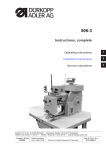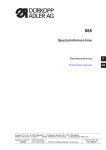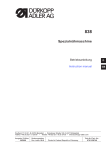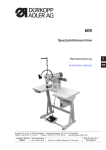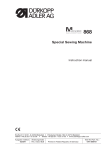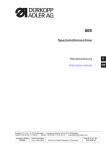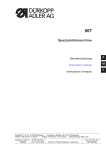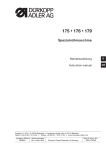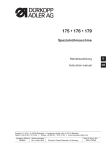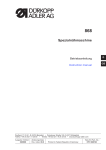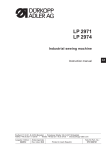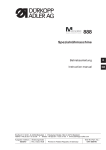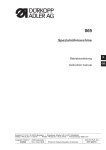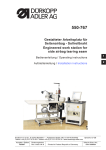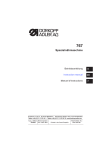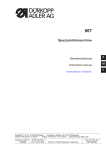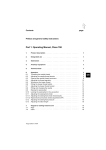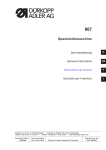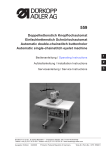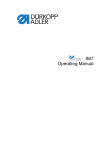Download Duerkopp Adler 838 Instruction manual
Transcript
838 Spezialnähmaschine Betriebsanleitung D Instruction manual GB Postfach 17 03 51, D-33703 Bielefeld • Potsdamer Straße 190, D-33719 Bielefeld Telefon +49 (0) 521 / 9 25-00 • Telefax +49 (0) 521 / 9 25 24 35 • www.duerkopp-adler.com Ausgabe / Edition: 10/2008 Änderungsindex Rev. index: 00.0 Printed in Federal Republic of Germany Teile-Nr./Part.-No.: 0791 838740 Alle Rechte vorbehalten. Eigentum der Dürkopp Adler AG und urheberrechtlich geschützt. Jede, auch auszugsweise Wiederverwendung dieser Inhalte ist ohne vorheriges schriftliches Einverständnis der Dürkopp Adler AG verboten. All rights reserved. Property of Dürkopp Adler AG and copyrighted. Reproduction or publication of the content in any manner, even in extracts, without prior written permission of Dürkopp Adler AG, is prohibited. Copyright © Dürkopp Adler AG - 2008 Foreword This instruction manual is intended to help the user to become familiar with the machine and take advantage of its application possibilities in accordance with the recommendations. The instruction manual contains important information on how to operate the machine securely, properly and economically. Observation of the instructions eliminates danger, reduces costs for repair and down-times, and increases the reliability and life of the machine. The instruction manual is intended to complement existing national accident prevention and environment protection regulations. The instruction manual must always be available at the machine/sewing unit. The instruction manual must be read and applied by any person that is authorized to work on the machine/sewing unit. This means: – – – Operation, including equipping, troubleshooting during the work cycle, removing of fabric waste, Service (maintenance, inspection, repair) and/or Transport. The user also has to assure that only authorized personnel work on the machine. The user is obliged to check the machine at least once per shift for apparent damages and to immediatly report any changes (including the performance in service), which impair the safety. The user company must ensure that the machine is only operated in perfect working order. Never remove or disable any safety devices. If safety devices need to be removed for equipping, repairing or maintaining, the safety devices must be remounted directly after completion of the maintenance and repair work. Unauthorized modification of the machine rules out liability of the manufacturer for damage resulting from this. Observe all safety and danger recommendations on the machine/unit! The yellow-and-black striped surfaces designate permanend danger areas, eg danger of squashing, cutting, shearing or collision. Besides the recommendations in this instruction manual also observe the general safety and accident prevention regulations! General safety instructions The non-observance of the following safety instructions can cause bodily injuries or damages to the machine. 1. The machine must only be commissioned in full knowledge of the instruction book and operated by persons with appropriate training. 2. Before putting into service also read the safety rules and instructions of the motor supplier. 3. The machine must be used only for the purpose intended. Use of the machine without the safety devices is not permitted. Observe all the relevant safety regulations. 4. When gauge parts are exchanged (e.g. needle, presser foot, needle plate, feed dog and bobbin) when threading, when the workplace is left, and during service work, the machine must be disconnected from the mains by switching off the master switch or disconnecting the mains plug. 5. Daily servicing work must be carried out only by appropriately trained persons. 6. Repairs, conversion and special maintenance work must only be carried out by technicians or persons with appropriate training. 7. For service or repair work on pneumatic systems, disconnect the machine from the compressed air supply system (max. 7-10 bar). Before disconnecting, reduce the pressure of the maintenance unit. Exceptions to this are only adjustments and functions checks made by appropriately trained technicians. 8. Work on the electrical equipment must be carried out only by electricians or appropriately trained persons. 9. Work on parts and systems under electric current is not permitted, except as specified in regulations DIN VDE 0105. 10. Conversion or changes to the machine must be authorized by us and made only in adherence to all safety regulations. 11. For repairs, only replacement parts approved by us must be used. 12. Commissioning of the sewing head is prohibited until such time as the entire sewing unit is found to comply with EC directives. 13. The line cord should be equipped with a country-specific mains plug. This work must be carried out by appropriately trained technicians (see paragraph 8). It is absolutely necessary to respect the safety instructions marked by these signs. Danger of bodily injuries ! Please note also the general safety instructions. Contents Page: Preface and general safety instructions Part 1: Operating instructions - Class 838 (Edition 10/2008) 1. Product description . . . . . . . . . . . . . . . . . . . . . . . . . . . . . . . . . . . . . . . . . . . . 5 2. Designated use . . . . . . . . . . . . . . . . . . . . . . . . . . . . . . . . . . . . . . . . . . . . . . . 5 3. 3.1 3.2 Subclasses and sewing equipment Subclasses . . . . . . . . . . . . . . . . . . . . . . . . . . . . . . . . . . . . . . . . . . . . . . . . . . Sewing equipment . . . . . . . . . . . . . . . . . . . . . . . . . . . . . . . . . . . . . . . . . . . . . 6 6 4. Optional equipment . . . . . . . . . . . . . . . . . . . . . . . . . . . . . . . . . . . . . . . . . . . . 7 5. 5.1 5.2 Technical data Class-specific technical data . . . . . . . . . . . . . . . . . . . . . . . . . . . . . . . . . . . . . . . Subclass-specific technical data . . . . . . . . . . . . . . . . . . . . . . . . . . . . . . . . . . . . . 8 8 6. 6.1 6.2 6.3 6.4 6.4.1 6.4.2 6.5 6.5.1 Operations Threading the needle thread . . . . . . . . . . . . . Winding on the hook thread . . . . . . . . . . . . . . Changing the hook thread bobbin . . . . . . . . . . Adjusting the thread tension . . . . . . . . . . . . . Adjusting the hook thread tension . . . . . . . . . . Adjusting the needle thread tension . . . . . . . . . Switching the thread tensioners on/off . . . . . . . The functioning of the main thread tension and the in relation to the sewing foot lift . . . . . . . . . . . . 6.6 Adjusting the thread regulator . . . . . . . . . . . . 6.7 Changing the needle for single-needle machines . 6.8 Changing the needle for double-needle machines 6.9 Lifting and folding the top roller . . . . . . . . . . . . 6.10 Sewing foot pressure . . . . . . . . . . . . . . . . . . 6.11 Sewing in reverse (back-tacking) . . . . . . . . . . 6.12 Adjusting the stitch length . . . . . . . . . . . . . . . 6.13 Engaging the safety clutch for hook blockages . . . 6.14 Operating the machine with the positioning drive . 6.14.1 With the pedal . . . . . . . . . . . . . . . . . . . . . . 6.14.2 With the buttons (key panel) . . . . . . . . . . . . . GB . . . . . . . . . . . . . . . . . . . . . . . . . . . . . . . . . . . . . . . . . . . . . . . . . . . . . . . . . . . . . . . . . . . . . . . . . . . . . . . . . . . . . . . . . . . . . . . . . . supplementary thread . . . . . . . . . . . . . . . . . . . . . . . . . . . . . . . . . . . . . . . . . . . . . . . . . . . . . . . . . . . . . . . . . . . . . . . . . . . . . . . . . . . . . . . . . . . . . . . . . . . . . . . . . . . . . . . . . . . . . . . . . . . . . . . . . . . . . . . . . . . . . . . . . . . . . . . . . . . . . . . . . . . . . . . . . . . . . . . . . . . . . . . . . . . . . . . . . . . . . . . . . . . tension . . . . . . . . . . . . . . . . . . . . . . . . . . . . . . . . . . . . . . . . . . . . . . . . . . . . . . . . . . . . . . . . . . . . . . . . . . . . . . . . . . . . . . . . . . . . . . . . . . . . . . . . . . . . . 9 10 10 11 11 12 13 . . . . . . . . . . . . . . . . . . . . . . . . . . . . . . . . . . . . . . . . . . . . . . . . . . . . . . . . . . . . . . . . . . . . . . . . . . . . . . . . . . . . 14 14 15 16 17 18 19 20 21 23 23 24 7. Positioning drive on the Efka DC 1550/DA321G . . . . . . . . . . . . . . . . . . . . . . . . . . 25 8. 8.1 8.2 Sewing on a machine with positioning drive Automatic machine functions . . . . . . . . . . . . . . . . . . . . . . . . . . . . . . . . . . . . . . . Example - operating the machine while sewing . . . . . . . . . . . . . . . . . . . . . . . . . . . . 26 27 Contents 9. 9.1 9.2 Maintenance Cleaning and testing . . . . . . . . . . . . . . . . . . . . . . . . . . . . . . . . . . . . . . . . . . . . Lubrication . . . . . . . . . . . . . . . . . . . . . . . . . . . . . . . . . . . . . . . . . . . . . . . . . . Page: 28 30 1. Product description The Dürkopp Adler 838 is a special all-purpose sewing machine. · · · · · · · · · · 2. It is a post-bed double-lockstitch machine. It has a bottom drop (feed) mechanism and a drive-powered top roller. There are two setting wheels (knobs) which allow the selection of two stitch lengths. There is also a pneumatically-controlled device with a button for toggling between the two stitch lengths during sewing. Depending on if the subclass is a single-needle or double-needle sewing machine, the following automatic functions are featured: an electro-magnetic thread trimmer, pneumatically-controlled bartacking, a sewing foot lift, and a switchable upper thread tensioner. The machine is equipped with a large double-sectioned vertical hook. The maximum lift for the sewing foot is 12 mm. There is a safety clutch to avoid displacing or damaging the hook if the thread gets jammed in the shuttle track. Depending on the width of the needle, swappable throat plate inserts with corresponding stitching holes can be swapped out at the throat plate. The machine features automatic wick lubrication and a viewing window in the arm for watching the machine and hook lubrication. Some of the oil is lost during the hook lubrication. The remaining oil is redirected by the pump back to the central reservoir. Integrated bobbin winder. Designated use The 838 machines are suitable for use in producing shoes, decorative ornamental work, and upholstery. The typical sewing material is leather (either natural or synthetic). The sewing machine can also be used for sewing shoe textiles. The setup of the machine depends on the material to be sewed and whether it is heavy or extra heavy. Generally only dry material may be sewn with this sewing unit. The material may be no thicker than 7 mm when compressed by the lowered top roller. The sewing material must not contain any hard objects since the sewing machine is not equipped with any form of eye protection. This sewing machine may be set up and operated only in dry, well-maintained premises. If the sewing machine is used in other premises which are not dry and well-maintained it may be necessary to take further precautions which should be agreed in advance (see EN 60204-31: 1999). As manufacturers of industrial sewing machines, we proceed on the assumption that personnel who work on our products will have received training at least sufficient to acquaint them with all normal operations and with any hazards which these may involve. 5 GB Subclasses and sewing equipment Subclasses 0838 170522 X Trimming and seam tacking large two-section with thread trimming, autom. seam tacking Hook X X X X X X X X 838-E3/1,6 838-E4/2,0 838-E5/2,4 838-E6/3,2 Standard max. stitch length Max. Standard * Top roller diameter Gearing gap for the feed dog Seam clearance gap Noise intensity level of machine ** Sewing speed Label number of polyester thread - - mm 1/min 1/min mm mm mm dB (A) Standard Range Needle width: Nm Sewing type Number of neeles Class and sub-class 0,01 mm 0838 170522 838-E2 0,01 mm 1 heavy 120-160 120 25-10 20 8 2000 1600 35 1,5 - 1 extra heavy 180-230 180 10-8 10 8 1600 1600 35 1,5 - 0838 270522 Sewing equipment Sewing equipment 838-E1 * Machinecontrol up to 8 mm X 0838 270522 3.2 Stitch length autom. foot lift pneumatic seam tacking Number of needles one needle, hook to right of needle Class and Subclass Range 3.1 two needles 3. 2 heavy 120-180 180 25-10 10 8 2000 1600 35 1,5 1,6 2 heavy 120-180 180 25-10 10 8 2000 1600 35 1,5 2,0 2 heavy 120-180 180 25-10 10 8 2000 1600 35 1,5 2,4 2 heavy 120-180 180 25-10 10 8 2000 1600 35 1,5 3,2 You must reduce the sewing speed significantly when sewing through very thick materials. ** Noise level of the special sewing machine at the work place, as measured for the maximum stitch length and the maximum sewing speed in compliance with DIN 45635-48-A-1-KL2. 6 4. Optional equipment Order No. Optional equipment 0888 220334 Top roller Æ 25 mm, knurled 0888 220344 Top roller Æ 25 mm, smooth 0888 220354 Top roller Æ 25 mm, rubber coating 0888 220364 Top roller Æ 35 mm, knurled (thoroughly) 0888 220374 Top roller Æ 35 mm, smooth 0888 220384 Top roller Æ 35 mm, rubber coating 0888 220394 Top roller Æ 45 mm, width: 3.8 mm 0888 220404 Top roller Æ 45 mm, width: 2.0 mm 9880 888100 Sewing lamp LED MG55-3 400324 Stand set for machines powered by drive belts (contains frame, pedal, drawer and table top 1060 x 50 mm) 0700 088804 Table top for drive belt N800 080030 Edge-guide, swivelling N800 080004 Edge-guide with roller, swivelling 9780 000108 Compressed air unit 0797 003031 Complete compressed air hose 9805 791113 USB memory key for transferring data with the Efka DA321G control unit 0867 490010 Holder bracket for the Efka V810 or V820 control panel 0688 130384 Knee level for mechanical foot lift 9880 002001 Knee switch GB 7 5. 5.1 Technical data Class-specific technical data Type of stitch Lockstitch 301 Needle system 134LR, 134 KKLR, 134, 134 D Foot lift with hand lever 6 mm Foot lift with knee lever or automatic 12 mm Remaining thread length after thread trimming max. 15 mm Clearance height of machine head 300 mm Clearance width of machine head 280 mm Dimensions of footprint of the machine bed plate 178 x 518 mm Dimensions of footprint of table plate 1060 x 500 mm Min. height of the table plate 740 mm Max. height of the table plate 900 mm Height of machine max. 1630 mm Max. (short-term) power consumption 0.8 kW Compressed air feed 6 bar Weight of Efka DC1550 motor Weight of frame mm mm mm kg kg kg 0838 170522 1 170 52 59 55 30 10 0838 270522 2 170 52 59 56 30 10 More detail about the technical data are given in the chapter 3.2. 8 Weight of machine head Column width perpendicular to sewing direction Column length Class and subclass Column heigth in sewing direction Subclass-specific technical data Number of needles 5.2 6. 6.1 Operations Threading the needle thread A B C D 4 1 2 3 5 2 3 2 3 GB Caution: danger of injury! Turn off the main switch. The needle must be threaded only when the machine is turned off. – – – – – Follow illustration A when threading single-needle sewing machines. If the sewing machine is outfitted for the sewing of heavy-duty materials, then wind the thread around the pin (1). Follow the illustration B (right side) when threading double-needle sewing machines. Insert the thread (2) for the left needle into the left thread tension device and then in the upper eyelet of the thread lever (4). When needles are situated side-by-side, thread the needle eye according to illustration B. When the needles are situated diagonally to each other, thread the needle according to the illustration C (right needle) and illustration D (left needle). If the sewing machine is intended for the sewing of heavy-duty materials, then wind the thread around the pin (5). 9 6.2 Winding on the hook thread 2 – – – – – – 6.3 1 3 4 Insert the thread as shown in the illustration. Stick the thread behind the knife blade (1). Then cut by pulling in the direction of arrow (2). Put the bobbin on the bobbin shaft and move the bobbin lever (3) in direction (4). Start up the machine. After the thread is wound around the bobbin, stick the thread once again behind the knife blade (1) and cut off. Put an empty bobbin on the bobbin shaft for the next winding process and move the bobbin lever. Changing the hook thread bobbin 2 10 3 6 1 4 5 Caution: danger of injury! Be sure to turn off the main switch and wait until the motor has completely stopped. – – – – – 10 Raise up the flap cover (1). Insert the bobbin (2) with the thread end (3) positioned as shown in the illustration. Pull the thread through slit (4) and slit (5). Then close the flap and secure the thread under the spring (6). Trim off the thread end as show in the illustration. The threading and bobbin insertion for the hook to the left of the needle should be carried out similarly. 6.4 Adjusting the thread tension 6.4.1 Adjusting the hook thread tension 3 1 2 Caution: danger of injury! Turn off the main switch. Adjust the shuttle thread tension only when the sewing machine is turned off. – – Adjust the shuttle thread tension by turning the screw (1) with a screwdriver. The screwdriver should be inserted through the opening (2). The tension is increased by tightening the screw. The thread tension should then be checked with a thread tension gauge (dynamometer). Insert the thread as shown in the illustration and pull in the direction of arrow (3). The thread tension set at the factory depends on the selected machine configuration (see table below). This tension setting is suitable for typical sewing processes. You should lower the tension when working with materials which are soft and thin. If the seam must be tightly sewn, then you should increase the tension while simultaneously lowering the sewing speed. Average values for hook thread tension Type of sewing Width of needle used Nm Thread tension in grams heavy 120-160 90 extra heavy 180-230 90 11 GB 6.4.2 Adjusting the needle thread tension 1 2 3 4 Adjusting the pre-tensioner (1) – When the main thread tensioner (3) and the supplementary tensioner (2) are open, there must still be a slight tension remaining on the needle thread. This residual tension is created by the pre-tensioner (1). The pre-tensioner (1) influences both the length of the cut needle thread and the starter thread for the next seam. (The pre-tensioner (1) is not deactivated with the sewing foot lift.) Adjusting the thread tension (2) and (3) – You can switch off the supplementary tensioner (2) by pressing the button (4). You can switch the supplementary tensioner (2) back on by pressing the button (4) again. The switchable supplementary tensioner (2) is helpful for quickly altering the needle thread tension. For example, it can be used to attain a good stitch draw and consistent stitch pattern when working with different textile materials within a single seam. – Press the button (4). – Make a seam on a few layers of materials and regulate the thread tension by means of the main tensioner (3) until the proper cross-over point is attained (see illustration). – Extend the material layers and press button (4) to activate the supplementary tensioner (2). Control until the proper cross-over point (thread binding) has been attained. 12 Correct thread interlacing in the center of the sewing material Needle thread tension too weak or Hook thread tension too strong. Needle thread tension too strong or Hook thread tension too weak. 6.5 Activating and deactivating the thread tension GB 1 2 3 4 – The pre-tensioner (1) should never be deactivated. – The main tensioner (3) and supplementary tensioner (2) are switched off using an electro-pneumatic cylinder. Deactivation can result from: · · · Pressing the button (4) (see chapter 6.4.2). Trimming cycle: during the cutting process, the main tensioner (3) and the supplementary tensioner (2) are temporarily turned off. The sewing foot lift (see chapter 6.5.1). 13 6.5.1 The influence of the sewing foot lift on the main thread tensioner and supplementary thread tensioner Button 4 (see chapter 6.5) on the machine’s key pad can be used to activate or deactivate the supplementary thread tension at any time. The parameter F-147 must be set to “1" for this to work. Sewing foot Parameter setting F-196=0 F-196=1 F-196=2 F-196=3 Sewing foot lift in the seam Thread Thread main supplementary tension setting 0 0 1 1 0 0 1 1 After thelift thread has been cut Thread Thread main supplementary tension setting 0 0 0 0 1 1 1 1 1 = Thread tension opened mechanically 0 = Thread tension closed mechanically · · 6.6 If the supplementary thread tensioner is open, the state of the sewing foot lift does not change. If the machine is turned off, the supplementary thread tension remains at its previously set state. Adjusting the thread regulator 2 1 1234 The thread regulator (2) is used to control the quantity of needle thread required by the stitch formation. The best sewing results can only be ensured when using a precisely adjusted thread regulator. – Loosen the screw (1). Move the thread regulator (2). Then tighten the screw (1). – For most sewing jobs, the thread regulator is best positioned when the right edge of the regulator is aligned with the number 3. – The setting at position 4 is appropriate when using a thin sewing material with a very short stitch. 14 6.7 Changing the needle for a single-needle machine 1 2 MAX. 3° 3 4 5 Caution: danger of injury! Turn the main switch off. Change the needle only when the sewing machine is switched off. – – – GB Move the lever (1) forward in order to loosen the screw which is used to fasten the needle. Pull the needle under and out from the needle bar. Insert a new needle with the needle scarf (2) positioned on the right, according to section cuts (3) or (4). Push in until the needle has reached the end stop located in the needle bar hole. The needle should not be positioned as shown in section cut (5). Then tighten the needle attachment screw and turn the lever back (1) to the rear. CAUTION Danger of breakage! A bad positioned needle can cause damage to the hook tip. When changing to a needle with a different thickness, the clearance between the hook and the needle, as well as the position of the stitch plate in relation to the post bed, must both be adjusted accordingly (check the service instructions). 15 6.8 Changing the needle for double-needle machines 1 2 3 4 5 MAX. 3° Caution: danger of injury! Only change the needle when the main tensioner is turned off and the motor has come to a stop. – – – Loosen screws (1). Pull the needles under and out from the needle bar. Insert the new needles with the needle scarf (2) according to section cuts (3) or (4). Push in until the needles have reached the end stop located in the needle bar holes. The needles should not be positioned as shown in section cut (5). Tighten the needle attachment screws. CAUTION Danger of breakage! Poorly positioned needles can cause damage to the hook tips. When changing to needles with a different thickness, the clearance between the hook and the needle, as well as the position of the stitch plate in relation to the post bed, must both be adjusted accordingly (check the service instructions). 16 6.9 Swiveling and lifting the top roller 1 3 4 Using the hand lever to lift the top roller – Lift the top roller by turning the lever (1) in the direction of the arrow until the end stop. The top roller is secured in the upper position by the lever. – In order to lower the top roller, turn the lever (1) back to the starting position. Or: – Lift the top roller pneumatically or with the knee lever (3). The lever then moves back to its starting position. – The machine can be kept on after the hand lever is used to raise the top roller (for example, when winding the lower looper thread). Using the knee lever to lift the sewing foot Press the knee lever (3) to raise the sewing foot. Release the knee lever to lower the sewing foot. Caution! The machine should not be running when the sewing foot is raised more than 6 mm over the stitch plate. On a running machine, the needle bar with the needle holder could collide with the sewing foot or in the press pad with the double-needle machines. Automatic and pedal lifting of the sewing foot – For sewing machines equipped with position drives, the sewing foot lifting process can be triggered by pressing the pedal (4) down backwards to position -1. The sewing foot is raised to its top dead centre point using either the integrated electro-magnet or the pneumatic cylinder. The sewing foot is lowered after the pedal is released. – The machine can be set so that the sewing foot is automatically raised after each machine stop and no backwards pedal press is required. In this case, after pressing the pedal the sewing foot is lowered to position +1. After the seam is completed, the sewing foot remains permanently raised (see chapter 8). This setting is described in chapters 6, 7, 8, and 9. 17 GB Swiveling the top roller – Turn the hand lever (1) downwards. The top roller is then secured in the upper position. – Swivel the top roller to the side by pressing in the direction of arrow. Caution: danger of injury! Only swivel the top roller after first turning off the main switch and waiting for the motor to stop. 6.10 Sewing foot pressure 1 – – – – 18 + The top roller pressure is adjusted with the setting wheel (1). Increasing the top roller pressure = Turn the setting wheel (1) clockwise. Decrease the top roller pressure = Turn the setting wheel (1) counterclockwise. The pressing force of the top roller should be set just high enough so that the sewing material is not lifted when the needle pulls out. You should also verify that the pressure does not prevent the material from moving properly. For machines equipped with electric magnets, the maximum pressing force for the top roller is 100 N. For pneumatic-cylinder machines, the maximum force is 160 N. 6.11 Sewing in reverse (bartacking) 1 2 3 Using the hand lever to sew backwards – Press the stitch regulator lever (1) downwards. The machine will sew backwards as long as the stitch regulator lever (1) is pressed down. GB Using the button to sew backwards – Press button (2) or move lever (3). The machine will sew backwards as long as the button (2) or the lever (3) remains depressed. Automatic seam bartacking – For machines equipped with positioning drives, the number of tack stitches at the seam start and seam end can be programmed. At seam start (after a previous thread cut), the machine automatically sews the selected start bartack. At seam end and pedal position -2, the selected final bartack is sewn and then thread cutting is begun. Tack programming is described in chapters 7, 8, and 9. 19 6.12 Adjusting the stitch length 3 2 4 1 The special sewing machine 838 is equipped with two setting wheels. This allows you to sew with two different stitch lengths which can be activated during the sewing process by pressing a button. The stitch lengths are set using the two setting wheels (1) and (4) found on the machine arm. – Set the larger stitch length with the upper setting wheel (1). Turn the setting wheel until the desired number (the stitch length in mm) is marked (3). – Set the smaller stitch length with the lower setting wheel (4). Turn the setting wheel until the desired number (the stitch length in mm) is marked (3). – Stitch lengths are equal for both forward and reverse sewing. CAUTION Danger of breakage! Make sure that the stitch length set with the lower setting wheel (4) is not larger as the stitch length set by the upper setting wheel (1). Note: In order to facilitate the process of adjusting the stitch lengths, the button (4) should be used to fix the stitch lengths so that they do not shift. 20 6.13 Engaging the safety clutch for hook blockages 2 1 When the thread gets jammed in the hook track, the safety clutch disengages. Caution: danger of injury! Turn off the main switch. The safety clutch should only be engaged when the machine is turned off. – – – – Turn the handwheel until the safety clutch engages. Turn the handwheel in the opposite direction until the hook is free. If the safety clutch is still disengaged, insert a screwdriver (1) in the opening (2). Then turn the handwheel until the safety clutch engages. Free up the blocked hook by removing the cause of disturbance. 21 GB For your notes: 22 6.14 Operating the machine with the positioning drive 6.14.1 With the pedal -2 -1 0 1 2 13 The pedal position is detected by a button with 16 different levels. Their meanings are listed in the table below: Pedal position Pedal movement Meaning -2 Fully backwards Command for cutting the thread (end of seam) -1 Half backwards Command for raising the sewing foot 0 Neutral rest position 1 Slightly forwards 2 More forwards Sew with minimal speed (first level) 3 More forwards Sew with more speed (second level) : : 13 Entirely forwards Refer to comment below GB Command for lowering the sewing foot : Sew with maximal speed (twelfth level) Comment: The following functions can be programmed to correspond with the rest position: – needle position (down/up) and sewing foot position (down/up) when stop in seam. – sewing foot position (up/down) after end of seam. (Pedal fully backwards, then in rest position) 23 6.14.2 With the buttons 6 Button 7 9 8 10 1 2 3 4 5 Function 1 Sew backwards manually The machine sews backwards for as long as the button is held down. 2 Position the needle in the upper or lower position. The function of the button can be set with the parameter F-242 (DA321): 1 = needle high/low 2 = needle high 3 = one stitch (The factory default for delivered machine is 1.) 3 Invoke or suppress the start/final bartacks In general, if the start and final bartacks are activated, then the next bartack is deactivated by pressing the button. If the start and final bartacks are deactivated, then the next bartack is activated by pressing the button. 4 Switching the stitch length The function of the button can be defined with parameter F-250 (DA321): 1 = pressing the button switches the stitch length between two pre-set values. 4 = pressing the button changes the stitch length to a lower value. A stitch is then sewn and the machine reverts back to the original (larger) stitch length. 5 Activating and deactivating the supplementary thread tension (see chapter 6.5) The button background is illuminated when the supplementary tension is activated. (The tension discs are closed.) By pressing the button the supplementary tension is deactivated and the button is not background lit (the tension discs are opened). LED 7 and 8 9 Example for adjusting a button (for example, 10): Function Display empty bobbin for residual thread monitor (left/right bobbin) LED display “Power On” By adjusting the screw 10 (located under button 1), you can assign the function of button 1 to the lever (6). - Select the function (for example, 1 = sew backwards manually) - Turn screw 10 (located under button 1) clockwise 90° (the slot is then positioned vertically). The function can now be invoked by both button 1 and the lever (6). Caution! Be sure to deactivate the existing function before changing the function of lever 6. 24 7. The Efka DC1550/DA321G positioning drive GB The DA321G control unit contains all required operational interfaces for switching functions and setting parameters. It is possible to operate without an operating panel, but the seam programming can no longer be carried out. The V810 and V820 operating panels can also be connected to the control unit. They are deliverable as accessories. Seam programming can be performed with the V820 operating panel. The “Efka DC1550 - DA321G” Operating Manual contains a more detailed description of the control unit (see also www.efka.net). 25 8. 8.1 Sewing on a machine with positioning drive Automatic machine functions The machine functions listed in the table below are dependent on the following factors which occur during the sewing process: – Pre-selected setting – Pedal position (according to the selection of the machine operation) – The particular procedure in the seam preparation Automatic function Pre-selected setting Needle positioning • Needle is down when machine stops in the seam • Needle is up when machine stops in the seam Note: After the seam end*, the machine always stops with the needle up. Tacking • Normal • Decorative** Start bartack • Simple • Double • Stitch count of normal forward tacking • Stitch count of decorative forward tacking • Stitch count of normal backwards tacking • Stitch count of decorative backwards tacking Final bartack • Simple • Double • Stitch count of normal backwards tacking • Stitch count of decorative backwards tacking • Stitch count of normal forward tacking • Stitch count of decorative forward tacking Thread trimming • Turned on • Turned off Automatic sewing foot lift • Lower sewing foot when stopped in seam • Raise sewing foot when stopped in seam * For pedal position -2, the seam is ended. If the thread trimmer is activated, then after end of function: thread trimmer on. ** The decorative bartack is a special case. This is because, from the beginning to the end of the tacking, the needle is in the same stitch insertion point as the previous stitch seam. When the sewing direction changes, the machine stands still for a moment. 26 The pre-selected automatic functions are described in the instructions included from the drive manufacturer. For a detailed description of the control unit, please consult the enclosed current issue of the operating manual of the motor manufacturer (see also www.efka.net) Additional automatic functions can be pre-selected by changing the drive parameters. Each of the functions has its own parameter number. A parameter value can then be selected for the parameter number. The parameters concerned are listed in the parameter sheet (in the accessory pack). 8.2 Example - operating the machine while sewing Pre-selected setting: · · · · · · · Operation Needle is down when machine stops in the seam Normal tacking Start bartack is doubled Final bartack is doubled Thread trimming is turned on Lowered sewing foot when stopped in seam Raised sewing foot at seam end GB Sewing step The machine is at standstill. The need is up. The sewing foot is raised. Load the workpiece. Press pedal to position +1. The sewing foot goes down Let up on pedal to position 0. The sewing foot goes up Correct the position of the workpiece. Press pedal to position +1. The sewing foot goes down Press pedal to position +3. Sewing the normal double tacking (tack rotary speed is defined by manufacturer) and subsequent sewing at speed level +3. Let up on pedal to position 0. Machine stops with needle down. Press pedal to position -1. The sewing foot goes up Turn workpiece in the needle. Press pedal to position +5. Sewing foot lowers and you can sew at the speed level as determined by the pedal. Press pedal to position -2. Lower rotary speed. Sewing the normal double tacking. Trim thread and machine is at rest with the need up. The sewing foot raises. Let up on pedal. The sewing foot remains raised. Take out the workpiece. 27 9. 9.1 Maintenance Cleaning and testing Caution: danger of injury! Turn the main switch off. Maintenance work on the sewing machine must only be carried out when the machine is switched off. All maintenance work must be carried out before or at the maintenance intervals defined in the table (check the “operational hours” column). When working with materials that are thick and fibrous, shorter maintenance intervals may be required. A clean machine is a trouble-free machine. 1 2 3 4 5 6 9 7 8 Maintenance work to perform Explanation Machine head Points to be particularly well cleaned: - Area below and around the stitch plate, feed dog (2), and top roller. - Area around the hook (7) - Bobbin housing (1) - Thread trimmer - Area around the needle - Remove sewing dust and residual thread. (for example, with compressed air) Operating interval (hours) 8 CAUTION! Be sure to hold the compressed air cleaner so that no sewing dust is blown into the oil collector. - Remove sewing dust and residual thread. (for, example with compressed air) Take off stitch plate, thread trim blade (4) and hook plunger ring (6). Remove the bobbin housing (5) from the hook. Clean the inner area of the hook. Clean the bobbin housing. In particular, look for residual adhesive on the surface (1). 20 - Check the hook. Check the play on the track between bobbin housing (5) and the hook (7). 500 28 Maintenance work to perform Explanation - Cleaning the oil collector Clean the oil collector (8) of dirt and contaminated oil. (It can be cleaned with a special vacuum cleaner.) Clean the fan screen (9). (It can be cleaned with the compressed air gun.) - Cleaning the fan screen Operating interval (hours) 20 20 6 4 8 2 10 1 2 3 GB Maintenance work to perform Explanation Pneumatic system The water level must not rise as far as filter insert (1). - Use pressure to blow out the water from water separator (2) after loosening the drain screw (3). 40 The filter insert (1) is used to filter out dirt and condensation. - Separate the machine from the compressed air supply. - Unscrew drain screw (3). There must be no pressure on the machine’s pneumatic system. - Unscrew the water separator (2). - Unscrew the filter insert (1). Wash out the dirty filter bowl and filter insert with benzine (do not use a cleaning solvent). Then blow dry. - Reassemble the service unit. 500 Check the water level in the pressure regulator. Clean the filter insert. Check the system for leaks. Operating interval (hours) 500 29 9.2 Lubrication 2 1 3 Caution: danger of injury! Oil can cause skin eruptions. Avoid protracted contact with the skin. In the event of contact, thoroughly wash the affected area. Caution! The handling and disposal of mineral oils is subject to legal regulation. Deliver used oil to an authorized collection point. Protect your environment. Take care not to spill oil. Oil the sewing machine exclusively with the lubricating oil DA-10, or equivalent oil with the following specifications: 2 – Viscosity at 40°C 10 mm /s – Flash point 150°C DA-10 is available from DÜRKOPP ADLER point of sale under the following part numbers: 250-ml container: 1 litre container: 2 litre container: 5 litre container: 9047 9047 9047 9047 000011 000012 000013 000014 All areas in the machine head that must be lubricated with oil are supplied from the central reservoir (1). – If the oil level falls below the “MIN” mark (3), you should re-fill through the hole (2) until the level reaches the “MAX” mark. – Be sure to check the oil level daily! Caution! Oil should only be re-filled in the central reservoir or shuttle track. Other places and points should not be individually lubricated. Otherwise, the oil could get into areas that are not supposed to be lubricated. 30

































